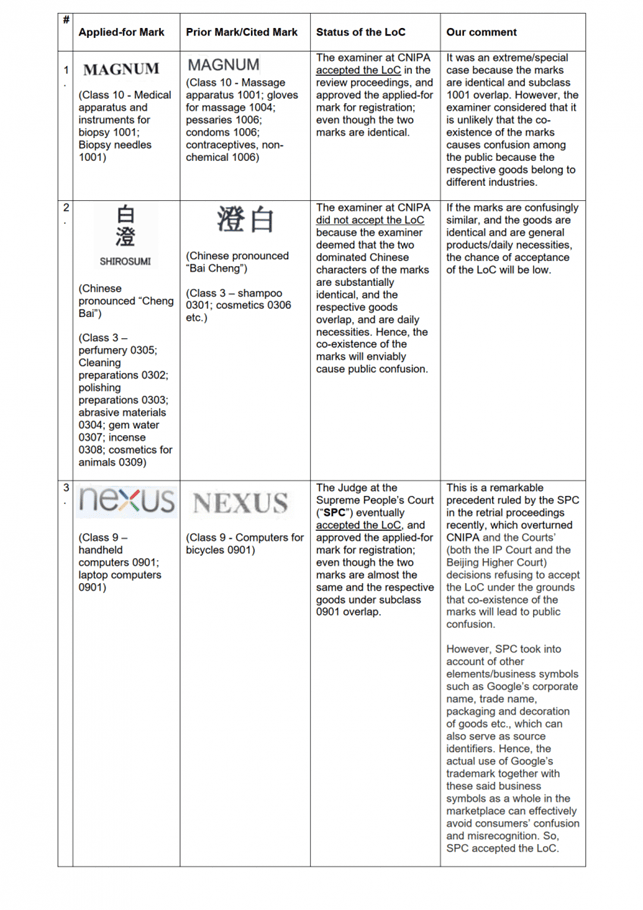China Trademark Practice – A Letter of Consent
6 Nov 2020
When trademark applicants/owners receive refusal of their trademark applications due to prior similar mark(s) flagged by the examiner, how can the applicants overcome the citation(s) by way of filing an application for review of the refusal with the China Intellectual Property Administration (“CNIPA”), in order to eventually have the applied-for mark approved for registration?
To overcome the citation(s) in the review proceedings, apart from arguing against the similarities between the respective marks, it will be very helpful to overcome the prior similar mark(s) by way of submitting a letter of consent (“LoC”) issued by the cited owner of the prior similar mark(s) agreeing on the use and registration of the applied-for mark in China, which is alternatively is called “co-existence agreement” in China.
We would like to share with you our views of the functions and practice of the LoC/co-existence agreement in China.
RELEVANT LAW/RULES/GUIDELINES
The PRC Trademark Law does not have specifical content and definition about LoC or co-existence agreement.
Nevertheless, in the “Trademark Trial and Appeal Rules” issued by CNIPA, Article 8 shows the parties can reach settlement dealing with the trademark rights. This is regarded as a basis of the LoC.
- Article 8 During the trademark review and hearing, a party shall have the right to, in accordance with the law, dispose of his own trademark right and the rights in connection with the trademark review and hearing. On the premise of considering public interests and the third-party rights, both parties concerned may reach a reconciliation agreement in written form, and the Trademark Review and Hearing Board may also hold mediations in this regard.
In addition, in the “2019 – Beijing High People’s Court Guidelines for the Trial of Trademark Right Granting and Verification Cases“ issued by the Beijing High People’s Court, the following three Articles are in relation to the nature, formalities, and legal effects of LoC:
- 15.10 When determining whether the respective marks are similar, a LoC could be prima facie evidence to obviate the confusion of the marks.
- 15.11 The LoC must be issued in written form by the cited owner specifying particulars of the applied-for mark and agreeing on use and registration of the applied-for mark. The LoC cannot have any condition and time limitation, otherwise, it shall not be accepted.
The LoC shall be genuine, legal, and valid, and not harm the interests of the state, the public and the third party, otherwise the LoC shall not be accepted.
- 15.12 If the respective marks are identical or substantially identical with each other, and their designated goods/services are identical or similar, the applied-for mark shall not be approved for registration based on the submitted LoC only.
If the respective marks are similar, their designated goods/services are identical or similar, and there is no evidence showing public confusion of the sources of goods/services caused by the marks’ co-existence, the respective marks shall be considered dissimilar under the LoC submitted.
OUR COMMENT
In accordance with the above-mentioned relevant Rules and Guidelines and the practice below, similar to other countries/jurisdictions like the U.S. and Hong Kong, the examiner at CNIPA, in particular the judge at the Courts tends to withdraw the citation(s) and approves the registration of the applied-for mark, if a LoC is submitted either in review proceedings or in Court proceedings.
To illustrate the acceptance of the LoC, we set out some landmark precedents in the table below for your reference:

In conclusion, we have successfully overcome prior marks by way of submitting LoCs. Despite the fact that China adopts case-by-case principle and precedents are not binding in China, based on the current practices, we believe that a LoC will be very helpful to overcome the prior similar mark(s). Although the examiner/judge has her/his discretion whether to accept a LoC based on the possibilities of confusion, there is a good chance that they will withdraw the citation(s) if the LoC is submitted; unless the marks are too similar, and the goods/services are identical.
One point to note is that the LoC must be notarized, if the cited owner is a foreign company/individual, the notarized LoC must be legalized by the local Chinese Consulate.
If you have any questions in relation to the LoC and/or protection of your trademark in China, please feel free to contact please contact evelyne.yeung@oln-law.com or angel.luo@oln-law.com,. We are happy to assist you in the matter, e.g. assessing the chance of acceptance of the LoC, approaching the cited owner for a LoC, preparing a LoC that is acceptable by CNIPA/Court, submitting the notarized and legalized LoC to CNIPA/Court, and requesting the examiner/judge in charge of the case to accept the LoC and approve your applied-mark for registration.
作者
最新文章

 香港中环雪厂街二号圣佐治大厦五楼503室
香港中环雪厂街二号圣佐治大厦五楼503室 +852 2868 0696
+852 2868 0696
















